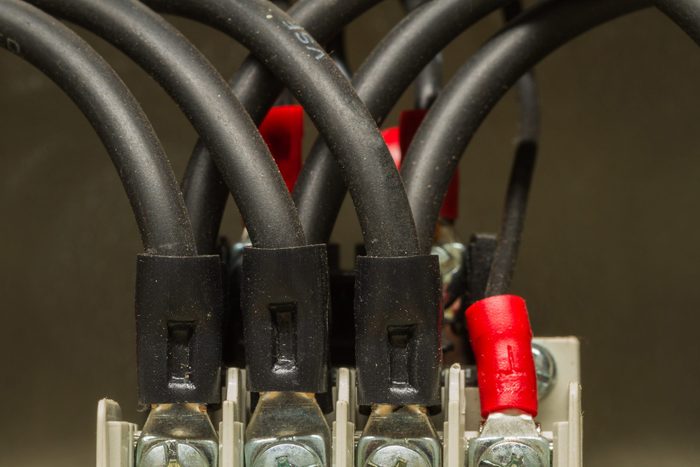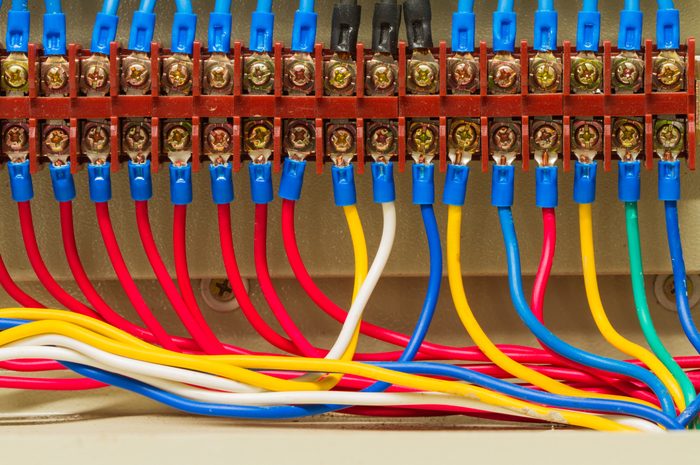If I Have a Red and Blue Wire Whats Positive and Negative
1 / 6

Black Wires
Black wires are "hot" wires. They carry current from the home's electrical panel to the light, appliance or other device that needs electricity. There's no NEC requirement that hot wires be black or any other color, but black is the go-to for residential use.
Black wires may also carry current from a light switch to a light. This section of a circuit is called a switch leg. Traveler wires, used to connect two or more switches that control one light, can also be black, although other colors are also used.
Because black wires are so commonly used to carry electricity, always assume they are hot. Verify the circuit is off at the breaker before cutting or disconnecting a black wire.
2 / 6
Red Wires
Red wires are also hot wires. Large appliances like air conditioners need 240 volts to operate, and that requires two hot wires instead of one. Black is often used for one hot, red for the other.
Red wires can be switch legs, too, particularly if you need two switch legs for one device. One example: a ceiling fan with an integrated light you want to control separately.
If you're in a newer home with hardwired smoke detectors, a red wire connects them so if one goes off, they all go off.
Red wires are used just like black wires, so assume they are hot. Always test any red wire before cutting or disconnecting.
3 / 6

White and Gray Wires
White and gray wires are grounded conductors, AKA neutrals. After a black or red wire carries electricity to a light, appliance or device, the neutral returns it to the panel. Then the process repeats in an endless loop.
The NEC allows grounded conductors to be white or gray, or have three white or gray stripes on any background color except green. Other configurations are permitted for specific applications.
White or gray wires with black, red or another color tape around the ends indicate the conductor is not being used as a neutral, but as a hot. Either way, these conductors carry current, so treat them as live at all times.
4 / 6

Green, Green-Yellow and Bare Wires
Green, green with yellow stripes and bare wires (wires without an insulated covering) are ground wires. Copper is the most common ground wire material, but aluminum can be used as well.
Ground wires act as a safety valve for current that takes an unintentional path away from the equipment it's supposed to be serving. Ground wires channel that unintentional current to the earth so people aren't shocked.
When a circuit is operating normally, ground wires do not carry current. But they can, so always test them before cutting or disconnecting them. You do not know if the previous homeowner — or electrician, for that matter — wired things correctly.
5 / 6

Blue and Yellow Wires
Blue and yellow wires are sometimes used as traveler wires in three- and four-way switches. Sometimes they're used as switch legs, particularly if your home's electrical wires go through pipes in the walls, attic or basement.
More often, though, a residential electrician will choose cables containing black and/or red wires as travelers or switch legs. These cables attach directly to the studs without the need for a protective pipe.
Blue and yellow wires are frequently found in commercial and industrial buildings that use three-phase power (your home is single-phase), but they can also be used in residential buildings. So even if you won't see these wires often, they're always used for carrying current. Treat any you see like they're live.
6 / 6

Orange, Brown, Pink and Violet Wires
Rounding out the list of electrical wire colors are orange, brown, pink and violet.
In U.S. homes, orange is most commonly used like a red wire, particularly in a 240-volt circuit where two hot wires are needed. You could see orange wires in the fire alarm circuit as well.
Pink and violet are less prevalent but can be used as travelers or switch legs, or as dimming control wiring for lights. Brown conductors are used primarily in three-phase services, but you could certainly see them in your home, too.
If this seems like a lot of colors, you're right. The NEC doesn't specify that hot conductors be any certain color. So having multiple recognizable options when running circuits, switch legs and travelers helps electricians stay organized and safe.
Originally Published: February 12, 2021
fitzgeraldlegst1959.blogspot.com
Source: https://www.familyhandyman.com/list/what-electrical-wire-colors-mean/

0 Response to "If I Have a Red and Blue Wire Whats Positive and Negative"
Post a Comment